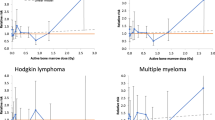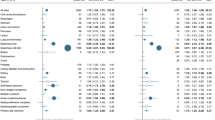Abstract
The risks of second primary cancer were analysed in 2846 patients with Hodgkin's disease treated within the British National Lymphoma Investigation during 1970-87. The relative risk (RR) of leukaemia was significantly greater in women (RR = 30.1; 95% confidence limits (CL) 13.0-59.5) than in men (RR = 10.9; 95% CL 4.7-21.5), and showed a significant trend of greater risk with younger age at first treatment (P < 0.001). The relative risk of solid cancers was similar between the sexes, but again significantly greater at young than at older ages of first treatment (P < 0.01). Non-Hodgkin's lymphoma relative risks, although not related to sex or age, were significantly related to histology of the original Hodgkin's disease, and were greatest after lymphocyte predominant Hodgkin's disease (RR = 55.6; 95% CL 18.0-129.7). The relative risk of second cancers did not vary significantly according to whether or not splenectomy had been performed. Leukaemia risk was non-significantly greater after splenectomy than with no splenectomy, which accorded with previous evidence of a modest increased risk associated with this operation. If the greater relative risk of solid second cancers after treatment at young than at older ages persists with longer follow-up, the incidence rates of these second primaries in patients treated young for Hodgkin's disease will become very substantial as they age. This emphasises the need to maintain long-term follow-up surveillance of young Hodgkin's disease patients apparently cured of their disease, and to continue to develop new less carcinogenic treatment regimens.
This is a preview of subscription content, access via your institution
Access options
Subscribe to this journal
Receive 24 print issues and online access
$259.00 per year
only $10.79 per issue
Buy this article
- Purchase on Springer Link
- Instant access to full article PDF
Prices may be subject to local taxes which are calculated during checkout
Similar content being viewed by others
Author information
Authors and Affiliations
Rights and permissions
About this article
Cite this article
Swerdlow, A., Douglas, A., Vaughan Hudson, G. et al. Risk of second primary cancer after Hodgkin's disease in patients in the British National Lymphoma Investigation: relationships to host factors, histology and stage of Hodgkin's disease, and splenectomy. Br J Cancer 68, 1006–1011 (1993). https://doi.org/10.1038/bjc.1993.470
Issue Date:
DOI: https://doi.org/10.1038/bjc.1993.470
This article is cited by
-
Lymphome non hodgkinien gastrique 7 ans après un lymphome hodgkinien. A propos d’un cas
Journal Africain d'Hépato-Gastroentérologie (2014)
-
Does autologous transplantation directly increase the risk of secondary leukemia in lymphoma patients?
Bone Marrow Transplantation (2007)
-
Epidemiology of Hodgkin's disease and non-Hodgkin's lymphoma
European Journal of Nuclear Medicine and Molecular Imaging (2003)



